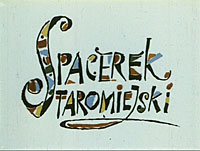 Spacerek staromiejski
Spacerek staromiejski
Poland, 1958, colour, 18 mins
By 1958, Andrzej Munk had already begun his second career as a maker of fiction features, and although A Walk in the Old Town of Warsaw was classified as a documentary short (and even won first prize in that category at the Venice International Documentary Festival), it works just as well as a fictional psychological study of a young violin student whose studies have made her hypersensitive to the creative potential of the sounds that she hears during an otherwise routine walk between lessons. It was based on an original idea by the composer Andrzej Markowski, whose electronic score is a substitute for any meaningful spoken content. The few words we hear are deliberately distorted and incorporated into the overall aural texture, the lack of subtitles confirming that they’re not meant to be understood.
We first meet the unnamed protagonist in a class full of fellow violin students. Unsurprisingly, given the lack of attention paid to anyone other than the boy playing at the front of the classroom, her mind quickly wanders, and when she starts looking out of the window at a crane swinging over the city, the sound of her classmate’s violin dissolves into electronic chirruping, which in turn is interrupted by the bell signalling the end of the lesson. Quickly changing her shoes to something more suited to walking, she sets off on a trip through Warsaw’s old quarter (is that Munk himself in the telephone box near the start of her journey?), encountering all manner of aural stimulation along the way.

Hearing a massed verse recitation from another classroom window, accompanied by the (electronically-heightened) sound of a besom broom sweeping the courtyard, she impulsively starts to “conduct” the end result. Popping into a church, she is enraptured both by the sight and sound of an organ being installed (the craftsman painstakingly testing each of the pipes before putting them into place) and the potential offered by the building’s echo – she takes out her violin and experimentally plucks the strings before being interrupted by a stern-looking priest.
After hitching a lift on a passing tractor, she hears a trio of cobblers at work, their tapping and leather-working taking on a distinctive rhythm, which she augments by playing with the bottles on their window sill. A walk past a fortress triggers an aural fresco of its past defensive activities, the camera mounting a whip-pan visual accompaniment around its architectural features. The water flowing out of the two spouts of a drinking fountain (a more recent film would undoubtedly have exploited their stereophonic potential) leads to a pitch-altering experiment with unfortunate consequences for the uniformed man who ends up being sprayed. Children play games in a ruined building, their rhythmic chants and huddled whispering suddenly erupting into full-on battle cries – which in turn are cut short by real fighter planes flying overhead. These and a barking dog introduce overtones of menace, abruptly changing the lyrical mood.
Finally, after racing up a spiral staircase, she reaches her destination – she’s having another violin lesson, only this time presumably on a one-to-one basis. Aside from the brief pizzicato interlude in the church, we never get to hear her play her instrument – but in many ways this would probably be a disappointment. At her age, she’s clearly not going to be able to translate her hyperactive aural imagination into anything meaningful – at least not yet. But the potential is clearly there.

By all accounts, this was one of Munk’s most personal films, and it’s easy to see why: the lack of any spoken content makes it far more open to individual interpretation, and its explorations of the creative potential of pure sound rank among the most inventive of any film of its era. Munk was a long-term music lover, and had already experimented with musical ideas informing a film’s structure in his second fiction feature Eroica (1957). Aside from its central scenario, it’s valuable both as a record of old Warsaw as it stood in the late 1950s, and it could also conceivably be screened as a visual demonstration of the principles of musique concrète, as natural sounds are usurped by Markowski’s electronic reimaginings. It’s certainly the most original of the Andrzej Munk documentaries that I’ve seen, and arguably the best.
- Director/Script: Andrzej Munk
- Camera: Kurt Weber
- Editing: Jadwiga Zajiček
- Sound: Zbigniew Wolski
- Music: Andrzej Markowski
- Production Manager: Michał Horowic
- Production Company: Wytwórnia Filmów Dokumentalnych (Documentary Film Studio)
The film is included on PWA’s Polish School of the Documentary: Andrzej Munk double-DVD set (Region 0 PAL). Although the original colours were doubtless more vivid than what’s presented here, the fading is less marked than was the case with its companion-piece One Sunday Morning (Niedzielny poranek, 1955), and the print is in excellent physical condition. Crucially, there are no serious issues with the soundtrack other than some very faint background crackle. The film doesn’t really need subtitles, though the childlike animated opening credits are given a full translation. Online commentary is provided by this Culture.pl overview of Munk’s career, which briefly mentions A Walk in the Old Town of Warsaw.